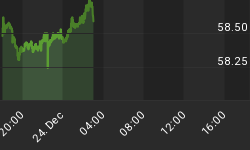Below is an excerpt from a commentary originally posted at www.speculative-investor.com on 16th January 2011.
Long-term price targets are meaningless
Many commentators like to speculate on where the dollar-denominated gold price is ultimately headed. Some claim that it is destined to reach $3,000/oz, others claim that it won't top until it hits at least $5,000/oz, and some even forecast an eventual rise to as high as $50,000/oz. All of these forecasts are meaningless.
Long-term dollar-denominated price targets are meaningless because they fail to account for the change in the dollar's purchasing power, and the only reason a rational person invests is to preserve or increase purchasing power. To further explain by way of a hypothetical example, assume that five years from now a US dollar buys only 20% of the everyday goods and services that it buys today. In this case, the US$ gold price will have to be around $7,000/oz just to maintain its current value in purchasing power terms. To put it another way, in our example a person who buys gold at around $1360/oz today and holds it will suffer a LOSS, in real terms (the only terms that matter), unless the gold price is above $7,000/oz in January-2016. Considering a non-hypothetical example to make the same point, a resident of Zimbabwe who owned a small amount of gold and not much else would have become a trillionaire a few years ago, and would also have become broke.
The purchasing power issue is why the only long-term forecasts of gold's value that we ever make are expressed in non-monetary terms. For example, throughout the past 10 years we've maintained that gold's long-term bull market would very likely continue until the Dow/gold ratio had fallen to at least 5, and would potentially continue until Dow/gold reached 1.
If we were forced to state a very long-term target for the US$ gold price then it would be: infinity. The US$ will eventually become worthless, at which point gold will have infinite value in US$ terms. But then, so will everything else that people want to own.
Current Market Situation
Gold futures broke below short-term support in the $1360s last Friday. For the February contract, the next levels of meaningful chart-related support lie in the $1320s and the $1270s.

We don't perceive a lot of downside risk in gold on either a short- or an intermediate-term basis. Despite the many assertions that gold is in a bubble and sentiment is too bullish, objective evidence indicates otherwise. For example:
1. The US$ gold price has essentially traded sideways over the past three months and at no stage over the past several months has it come close to the top of the moving-average envelope that has limited intermediate-term advances over the past decade.
2. Market Vane's bullish consensus for gold never exceeded 85% over the past few months and dropped below 70% last week. It could do what it did last July and fall as far as 60% before a correction low is in place, but the Market Vane survey suggests that the sentiment situation is now constructive.
3. Other sentiment indicators are consistent with the Market Vane survey. We note, for instance, that there has been a large decline in the speculative net-long position in COMEX gold futures and that the gold-stock indices are at low levels relative to gold bullion.
The sentiment picture suggests that a correction low will be put in place within the next three weeks and that support in the $1270s defines the maximum downside risk. Support in the $1320s is a more likely short-term price floor.
We aren't offering a free trial subscription at this time, but free samples of our work (excerpts from our regular commentaries) can be viewed at: http://www.speculative-investor.com/new/freesamples.html















